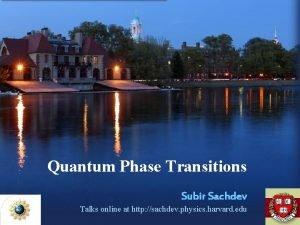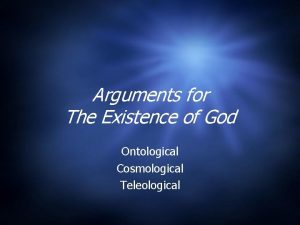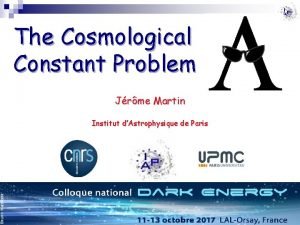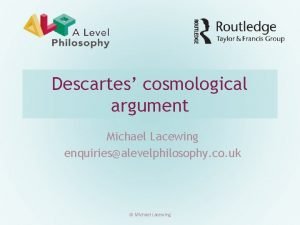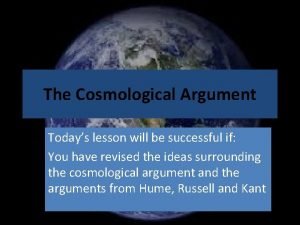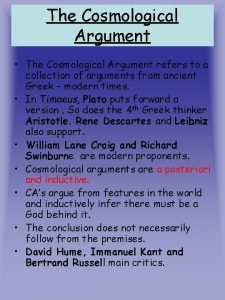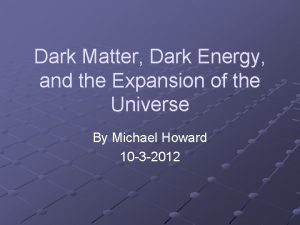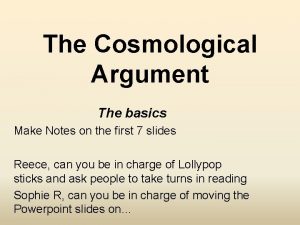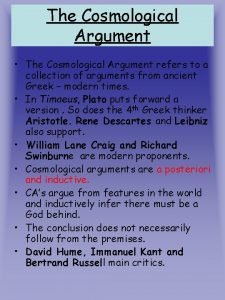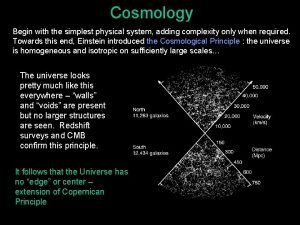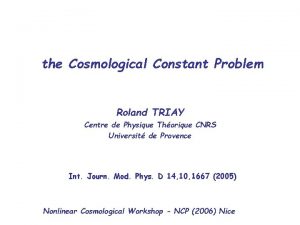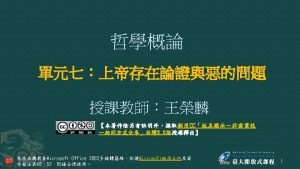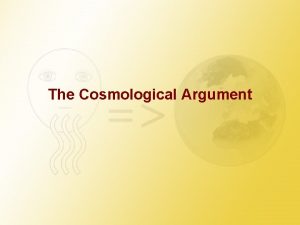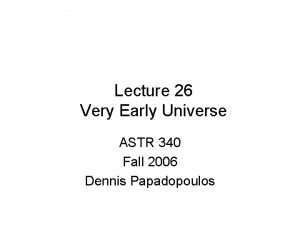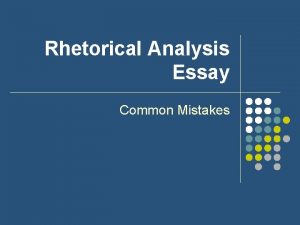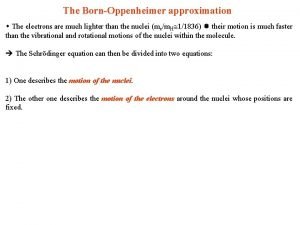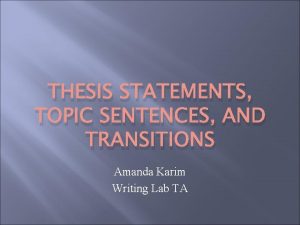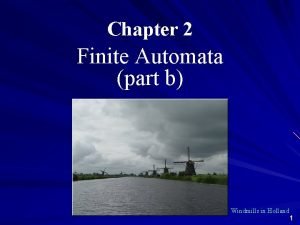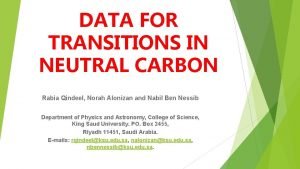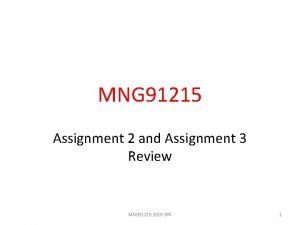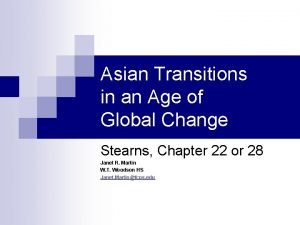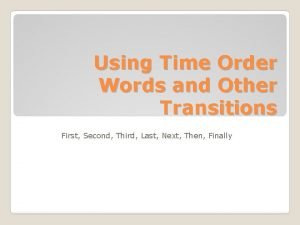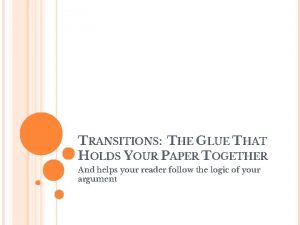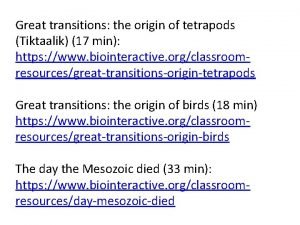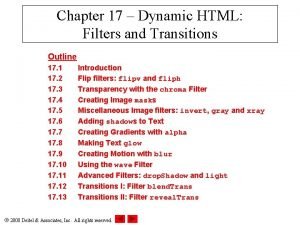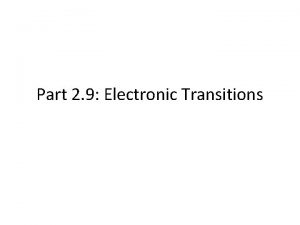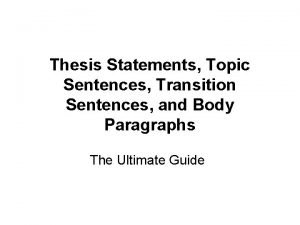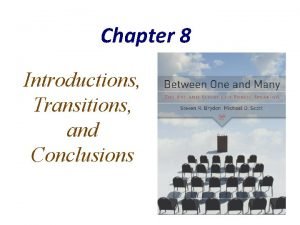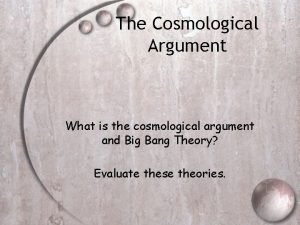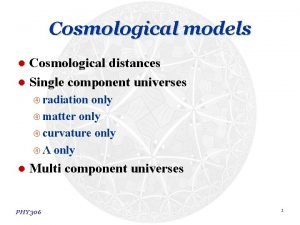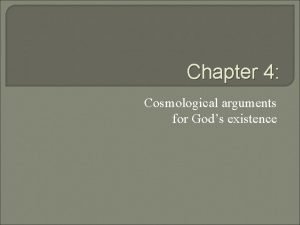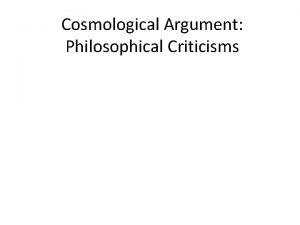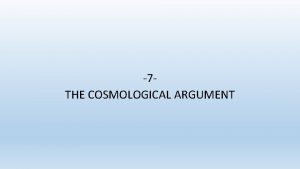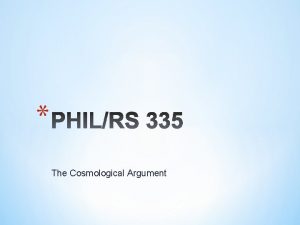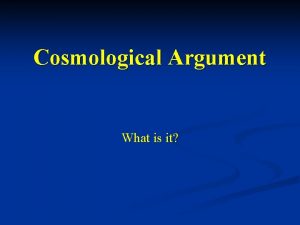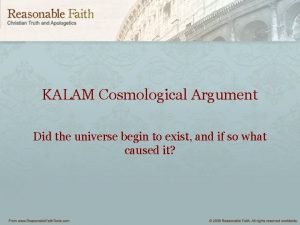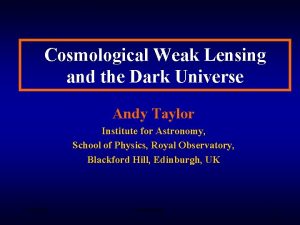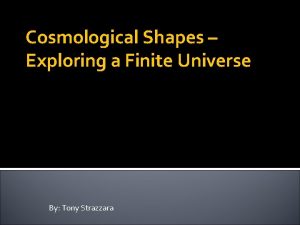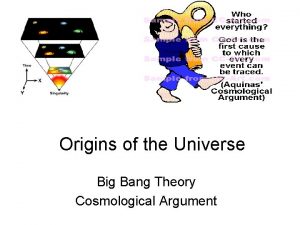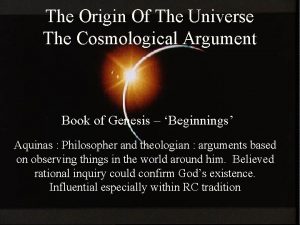Phase transitions in the early universe Cosmological phase
















































































- Slides: 80

Phase transitions in the early universe

Cosmological phase transition… …when the universe cools below 175 Me. V 10 -5 seconds after the big bang Quarks and gluons form baryons and mesons before: simply not enough volume per particle available

Seen in experiment ? Phase transition ? Heavy ion collision

Cosmological relics ? • Only if transition is first order • Out of equilibrium physics is crucial • Otherwise : the universe forgets detailed initial conditions after phase transition • In thermal equilibrium only a few quantities like temperature T or chemical potential μ determine the state

Cosmological phase transitions • QCD phase transition • Electroweak phase transition • • T=175 Me. V T=150 Ge. V baryogenesis ? GUT phase transition(s) ? T=1016 Ge. V monopoles, cosmic strings ? “inflation” T=1015 Ge. V primordial density fluctuations ! primordial magnetic fields ?

Order of the phase transition is crucial ingredient for cosmological phase transition and experiments ( heavy ion collisions )

Order of the phase transition temperature dependence of order parameter

Second order phase transition

First order phase transition

Electroweak phase transition ? • 10 -12 s after big bang • fermions and W-, Z-bosons get mass • standard model : crossover Reuter, Wetterich ‘ 93 • baryogenesis if first order ( only for some SUSY – models ) bubble formation of “ our vacuum “ Kuzmin, Rubakov, Shaposhnikov ‘ 85 , Shaposhnikov ‘ 87

Electroweak phase diagram M. Reuter, C. Wetterich Nucl. Phys. B 408, 91(1993)

Masses of excitations (d=3) small MH O. Philipsen, M. Teper, H. Wittig ‘ 97 large MH

Continuity

Higgs phase and confinement can be equivalent – then simply two different descriptions (pictures) of the same physical situation Is this realized for QCD ? Necessary condition : spectrum of excitations with the same quantum numbers in both pictures - known for QCD : mesons + baryons -

QCD at high temperature • Quark – gluon plasma • Chiral symmetry restored • “Deconfinement” ( no linear heavy quark potential at large distances ) • Lattice simulations : both effects happen at the same temperature

Chiral symmetry restoration at high temperature Low T SSB <φ>=φ ≠ 0 0 High T SYM <φ>=0 at high T : less order more symmetry examples: magnets, crystals

QCD – phase transition Quark –gluon plasma Hadron gas • Gluons : 8 x 2 = 16 • Light mesons : 8 • Quarks : 9 x 7/2 =12. 5 • (pions : 3) • Dof : 28. 5 • Dof : 8 Chiral symmetry Chiral sym. broken Large difference in number of degrees of freedom ! Strong increase of density and energy density at Tc !

Understanding the phase diagram

Phase diagram for ms > mu, d quark-gluon plasma “deconfinement” quark matter : superfluid B spontaneously broken vacuum nuclear matter : B, isospin (I 3) spontaneously broken, S conserved

Order parameters • Nuclear matter and quark matter are separated from other phases by true critical lines • Different realizations of global symmetries • Quark matter: SSB of baryon number B • Nuclear matter: SSB of combination of B and isospin I 3 neutron-neutron condensate

Phase diagram for ms > mu, d quark-gluon plasma “deconfinement” vacuum quark matter : superfluid B spontaneously broken nuclear matter : B, isospin (I 3) spontaneously broken, S conserved

“minimal” phase diagram for equal nonzero quark masses

Endpoint of critical line ?

How to find out ?

Methods • Lattice : You have to wait until chiral limit is properly implemented ! • Models : Quark meson models cannot work Higgs picture of QCD ? • Experiment : Has Tc been measured ? Indications for first order transition !

Lattice

Lattice results e. g. Karsch, Laermann, Peikert Critical temperature in chiral limit : Nf = 3 : Tc = ( 154 ± 8 ) Me. V Nf = 2 : Tc = ( 173 ± 8 ) Me. V Chiral symmetry restoration and deconfinement at same Tc

pressure

realistic QCD • precise lattice results not yet available for first order transition vs. crossover • also uncertainties in determination of critical temperature ( chiral limit …) • extension to nonvanishing baryon number only for QCD with relatively heavy quarks

Models

Analytical description of phase transition • Needs model that can account simultaneously for the correct degrees of freedom below and above the transition temperature. • Partial aspects can be described by more limited models, e. g. chiral properties at small momenta.

Universe cools below 175 Me. V… Both gluons and quarks disappear from thermal equilibrium : mass generation Chiral symmetry breaking mass for fermions Gluons ? Analogous situation in electroweak phase transition understood by Higgs mechanism Higgs description of QCD vacuum ?

Higgs phase and confinement can be equivalent – then simply two different descriptions (pictures) of the same physical situation Is this realized for QCD ? Necessary condition : spectrum of excitations with the same quantum numbers in both pictures Higgs picture with mesons, baryons as excitations?

Higgs picture of QCD “spontaneous breaking of color “ in the QCD – vacuum octet condensate for Nf = 3 ( u, d, s ) C. Wetterich, Phys. Rev. D 64, 036003(2001), hep-ph/0008150

Quark –antiquark condensate

Octet condensate < octet > ≠ 0 : • “Spontaneous breaking of color” • Higgs mechanism • Massive Gluons – all masses equal • Eight octets have vev • Infrared regulator for QCD

Flavor symmetry for equal quark masses : octet preserves global SU(3)-symmetry “diagonal in color and flavor” “color-flavor-locking” (cf. Alford, Rajagopal, Wilczek ; Schaefer, Wilczek) All particles fall into representations of the “eightfold way” quarks : 8 + 1 , gluons : 8

Quarks and gluons carry the observed quantum numbers of isospin and strangeness of the baryon and vector meson octets ! They are integer charged!

Low energy effective action γ=φ+χ

…accounts for masses and couplings of light pseudoscalars, vector-mesons and baryons !

Phenomenological parameters • 5 undetermined parameters • predictions

Chiral perturbation theory + all predictions of chiral perturbation theory + determination of parameters

Chiral phase transition at high temperature High temperature phase transition in QCD : Melting of octet condensate Lattice simulations : Deconfinement temperature = critical temperature for restoration of chiral symmetry Why ?

Simple explanation :

Higgs picture of the QCD-phase transition A simple mean field calculation gives roughly reasonable description that should be improved. Tc =170 Me. V First order transition

Experiment

Has the critical temperature of the QCD phase transition been measured ?

Heavy ion collision

Chemical freeze-out temperature Tch =176 Me. V hadron abundancies

Exclusion argument hadronic phase with sufficient production of Ω : excluded !!

Exclusion argument Assume T is a meaningful concept complex issue, to be discussed later Tch < Tc : hadrochemical equilibrium Exclude Tch much smaller than Tc : say Tch > 0. 95 Tc 0. 95 < Tch /Tc < 1

Has Tc been measured ? • Observation : statistical distribution of hadron species with “chemical freeze out temperature “ Tch=176 Me. V • Tch cannot be much smaller than Tc : hadronic rates for T< Tc are too small to produce multistrange hadrons (Ω, . . ) • Only near Tc multiparticle scattering becomes important ( collective excitations …) – proportional to high power of density Tch≈Tc P. Braun-Munzinger, J. Stachel, C. Wetterich, Phys. Lett. B (2004)

Tch ≈ Tc

Phase diagram < φ> ≈ 0 <φ>= σ ≠ 0

Temperature dependence of chiral order parameter Does experiment indicate a first order phase transition for μ = 0 ?

Second order phase transition for T only somewhat below Tc : the order parameter σ is expected to be close to zero and deviate substantially from its vacuum value This seems to be disfavored by observation of chemical freeze out !

Temperature dependent masses • Chiral order parameter σ depends on T • Particle masses depend on σ • Chemical freeze out measures m/T for many species • Mass ratios at T just below Tc are close to vacuum ratios

Ratios of particle masses and chemical freeze out at chemical freeze out : • ratios of hadron masses seem to be close to vacuum values • nucleon and meson masses have different characteristic dependence on σ • mnucleon ~ σ , mπ ~ σ -1/2 • Δσ/σ < 0. 1 ( conservative )

first order phase transition seems to be favored by chemical freeze out …or extremely rapid crossover

conclusion • Experimental determination of critical • • temperature may be more precise than lattice results Rather simple phase structure is suggested Analytical understanding is only at beginning

end

How far has first order line been measured? quarks and gluons hadrons

Exclusion argument for large density hadronic phase with sufficient production of Ω : excluded !!

First order phase transition line quarks and gluons μ=923 Me. V hadrons transition to nuclear matter

Phase diagram for ms > mu, d quark-gluon plasma “deconfinement” vacuum quark matter : superfluid B spontaneously broken nuclear matter : B, isospin (I 3) spontaneously broken, S conserved

Is temperature defined ? Does comparison with equilibrium critical temperature make sense ?

Prethermalization J. Berges, Sz. Borsanyi, CW bulk quantity mode quantity Scalar – fermion – model with Yukawa coupling

Vastly different time scales for “thermalization” of different quantities here : scalar with mass m coupled to fermions ( linear quark-meson-model ) method : two particle irreducible nonequilibrium effective action ( J. Berges et al )

Prethermalization equation of state p/ε similar for kinetic temperature

different “temperatures”

Mode temperature np : occupation number for momentum p late time: Bose-Einstein or Fermi-Dirac distribution


Kinetic equilibration before chemical equilibration

Once a temperature becomes stationary it takes the value of the equilibrium temperature. Once chemical equilibration has been reached the chemical temperature equals the kinetic temperature and can be associated with the overall equilibrium temperature. Comparison of chemical freeze out temperature with critical temperature of phase transition makes sense

Key argument • Two particle scattering rates not sufficient to produce Ω • “multiparticle scattering for Ω-production “ : dominant only in immediate vicinity of Tc

Mechanisms for production of multistrange hadrons Many proposals • Hadronization • Quark-hadron equilibrium • Decay of collective excitation (σ – field ) • Multi-hadron-scattering Different pictures !

Hadronic picture of Ω - production Should exist, at least semi-quantitatively, if Tch < Tc ( for Tch = Tc : Tch>0. 95 Tc is fulfilled anyhow ) e. g. collective excitations ≈ multi-hadron-scattering (not necessarily the best and simplest picture ) multihadron -> Ω + X should have sufficient rate Check of consistency for many models Necessary if Tch≠ Tc and temperature is defined Way to give quantitative bound on Tch / Tc

Energy density Lattice simulations Karsch et al even more dramatic for first order transition

Production time for Ω multi-meson scattering π+π+π+K+K -> Ω+p strong dependence on “pion” density P. Braun-Munzinger, J. Stachel, CW

extremely rapid change lowering T by 5 Me. V below critical temperature : rate of Ω – production decreases by factor 10 This restricts chemical freeze out to close vicinity of critical temperature 0. 95 < Tch /Tc < 1
 Effects of transitions in early years
Effects of transitions in early years Subir sachdev quantum phase transitions
Subir sachdev quantum phase transitions Ontological cosmological teleological
Ontological cosmological teleological Cosmological constant
Cosmological constant Descartes cosmological argument
Descartes cosmological argument Kant's criticism of cosmological argument
Kant's criticism of cosmological argument St thomas aquinas cosmological argument
St thomas aquinas cosmological argument Einstein cosmological constant
Einstein cosmological constant Contigency argument
Contigency argument St thomas aquinas cosmological argument
St thomas aquinas cosmological argument Cosmological redshift equation
Cosmological redshift equation Cosmological constant
Cosmological constant Argument from contingency
Argument from contingency St thomas aquinas cosmological argument
St thomas aquinas cosmological argument Early universe timeline
Early universe timeline Early cpr and early defibrillation can: *
Early cpr and early defibrillation can: * Logical transitions
Logical transitions How to imbed quotes in an essay
How to imbed quotes in an essay Transitions for rhetorical analysis
Transitions for rhetorical analysis Born oppenheimer
Born oppenheimer Melcon writing
Melcon writing Tlq transitions
Tlq transitions Subjective descriptive essay
Subjective descriptive essay One thesis statement
One thesis statement Finite automata with epsilon transitions
Finite automata with epsilon transitions Problem and solution transition words
Problem and solution transition words What are transitions?
What are transitions? Melcon writing
Melcon writing Windows live movie maker
Windows live movie maker Sherlock transitions
Sherlock transitions National transitions of care coalition
National transitions of care coalition Transitional devices
Transitional devices Rabia transitions
Rabia transitions William bridges transitions model
William bridges transitions model Transitions in screenplays
Transitions in screenplays Asian transitions in an age of global change
Asian transitions in an age of global change Christine weller
Christine weller Time order words
Time order words Mel-con
Mel-con Conclusion transitions
Conclusion transitions Great transitions the origin of tetrapods
Great transitions the origin of tetrapods Conjunctive adverb
Conjunctive adverb Vertical blinds
Vertical blinds Transition words in argumentative essay
Transition words in argumentative essay Process discriminants in software project management
Process discriminants in software project management Transition words for essays 6th grade
Transition words for essays 6th grade Spin selection rule
Spin selection rule Elaboration transition words
Elaboration transition words Gregory is my beautiful gray persian cat
Gregory is my beautiful gray persian cat Transition word for thesis statement
Transition word for thesis statement Transitions for conclusions
Transitions for conclusions Coordinators subordinators and transitions
Coordinators subordinators and transitions Century cpu
Century cpu Quá trình desamine hóa có thể tạo ra
Quá trình desamine hóa có thể tạo ra Công của trọng lực
Công của trọng lực Thế nào là mạng điện lắp đặt kiểu nổi
Thế nào là mạng điện lắp đặt kiểu nổi Hình ảnh bộ gõ cơ thể búng tay
Hình ảnh bộ gõ cơ thể búng tay Dạng đột biến một nhiễm là
Dạng đột biến một nhiễm là Vẽ hình chiếu đứng bằng cạnh của vật thể
Vẽ hình chiếu đứng bằng cạnh của vật thể Thế nào là sự mỏi cơ
Thế nào là sự mỏi cơ Phản ứng thế ankan
Phản ứng thế ankan Chó sói
Chó sói Các môn thể thao bắt đầu bằng tiếng nhảy
Các môn thể thao bắt đầu bằng tiếng nhảy Khi nào hổ con có thể sống độc lập
Khi nào hổ con có thể sống độc lập Thiếu nhi thế giới liên hoan
Thiếu nhi thế giới liên hoan điện thế nghỉ
điện thế nghỉ Một số thể thơ truyền thống
Một số thể thơ truyền thống Trời xanh đây là của chúng ta thể thơ
Trời xanh đây là của chúng ta thể thơ Slidetodoc
Slidetodoc Thế nào là số nguyên tố
Thế nào là số nguyên tố Phối cảnh
Phối cảnh Các châu lục và đại dương trên thế giới
Các châu lục và đại dương trên thế giới Tư thế worm breton
Tư thế worm breton Thế nào là hệ số cao nhất
Thế nào là hệ số cao nhất Hệ hô hấp
Hệ hô hấp ưu thế lai là gì
ưu thế lai là gì Tư thế ngồi viết
Tư thế ngồi viết Cái miệng xinh xinh thế chỉ nói điều hay thôi
Cái miệng xinh xinh thế chỉ nói điều hay thôi đặc điểm cơ thể của người tối cổ
đặc điểm cơ thể của người tối cổ Cách giải mật thư tọa độ
Cách giải mật thư tọa độ Bổ thể
Bổ thể

